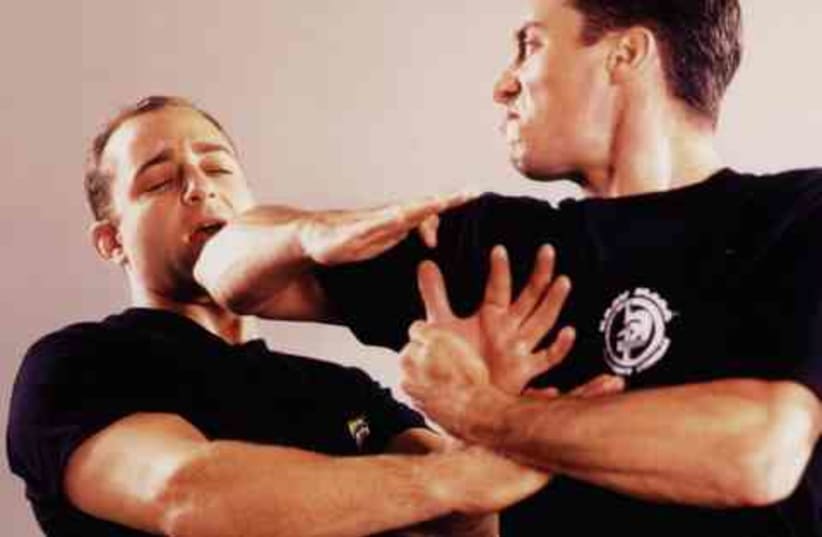One of the most amazing aspects of the Jewish State is its ability to defend itself. A large part of this success is because of Krav Maga. Literally translated to “Contact Combat” in Hebrew, Krav Maga is a self-defense system that was developed in Israel and used by Israel Defense Forces (IDF). But the story of its inspiring creation goes all the way back to Europe.
Imi Lichtenfeld, a Jewish wrestler and boxer, fought off fascist groups in Bratislava in the mid-late 1930s. Although part of his ability to fight off these groups came from his athletic training, much of it what was due to the instincts he had honed as a street fighter defending himself against anti-Semitic attacks. When he came to pre-state Palestine in the late 1940s, he taught his “Krav Maga” street-fighting techniques to soldiers in the War of Independence.
Afterwards, it was refined for the IDF. Today, it is used in the IDF, the FBI, military and police units around the world, and for individual selfdefense and fitness.
After finding out so much about Krav Maga, I decided to try it out for myself.
I entered the underground Krav Maga Studio at Manhattan’s 49th Street and 2nd Avenue with no idea what to expect.
I was greeted by a friendly receptionist, who right away gave me waivers to Discovering Israel 2012 June 18 Learning Krav Maga: A surprisingly safe form of Israeli self-defense.
With phrases like “in case of injury or death,” I feared for the worse.
I cautiously entered the studio and by the end of my hour-long class, I realized that I couldn’t have been more wrong. I was greeted by the male instructor who immediately paired me up with one of the most advanced guys in the class. I was struck by each student wearing the same black Krav Maga shirt and long athletic pants, but it was the sounds I won’t soon forget – screams, thuds, and the squeak of sneakers on the floor. It got really crazy when the teacher gave out the pads. The students attacked each other as hard as they could, with movie stunt knees to the body. When my turn came, I was expecting something to go wrong, maybe even something painful. Throughout the drill, my eyes thought I should be hurting. But I wasn’t! Looking back, I am amazed at how safe and coordinated Krav Maga really is.
After trying out Krav Maga, I wanted to learn more about it. I asked Avital Zeisler of Krav NYC in New York City a few questions.
Benjamin: How popular is Krav Maga in Israel?
Avital: In Israel, Krav Maga is fairly well known as it is taught to all people in the military and of course in Israel everyone goes to the military.
B: Why do you think it is popular in the US?
A: As a business it is still growing in that it is gaining recognition and popularity. The rise of UFC and Mixed Martial Arts in America has really been helping the popularity of it and other fighting styles in general.
B: What is the ideal age for starting Krav Maga?
A: Pure Krav Maga (hand-to hand combat with gun protection techniques) is recommended to boys who have passed Bar Mitzvah Age.
B: Who do you generally see attending classes most?
A: In this facility you have a majority of adults and a mix of men and women from about ages 15-50.
B: How long would it take someone to master Krav Maga?
A: It would take somebody about nine months to be proficient in Krav Maga.
B: What fighting style is Krav Maga most closely related to?
A: Other self-defense systems such as Russian Systema and also Ji-kundo from Japan.
B: Why take Krav Maga over other martial arts or forms of exercise?
A: Krav Maga is for street selfdefense; its only rule is that there are no rules. Krav Maga is the only martial art that encourages the use of eye-gouges or knees to the groin if the opportunity presents itself.
B: Do people view Krav Maga as a form of fitness exercise in Israel or is it thought of as a form of self-defense?
A: I am shocked to hear that it is viewed for fitness rather than its practicality as an art of selfdefense. Krav Maga should be known for its ability to teach one to defend themselves with fitness as an added benefit.
B: Are there competitions in Krav Maga?
A: You can’t do competitions in Krav Maga due to its violence and lack of rules.
B: Do you think that there is room for competition in Krav Maga?
A: It would be too dangerous to have in competition.
B: Why do you think that people should take up Krav Maga? What are its benefits?
A: People need to take Krav Maga for self-defense. Its indirect benefits are heightened fitness and mental levels. Krav Maga translates to people’s lifestyle and makes them sharper, more confident, and more pro-active.
B: How safe is Krav Maga?
A: Krav Maga is very safe! We do everything in our power to prevent injury and use of force has been carefully planned out.
B: Do you think that Krav Maga and its style represent Israel necessarily?
A: Of course. It represents the ability of somebody to out-smart an attacker that is bigger. It is an innovative system that requires body mechanics and proper technique to eliminate any threat.
So what did I learn in the end? Anyone of any shape or size can master Krav Maga and it can help overcome size and gender differences in any fight.
It’s also great knowing that you are receiving the same combat training as soldiers in the IDF. All in all, Krav Maga is an excellent recreational activity, and is one whose popularity all around the world can only go up. I also can’t wait for my next class.
